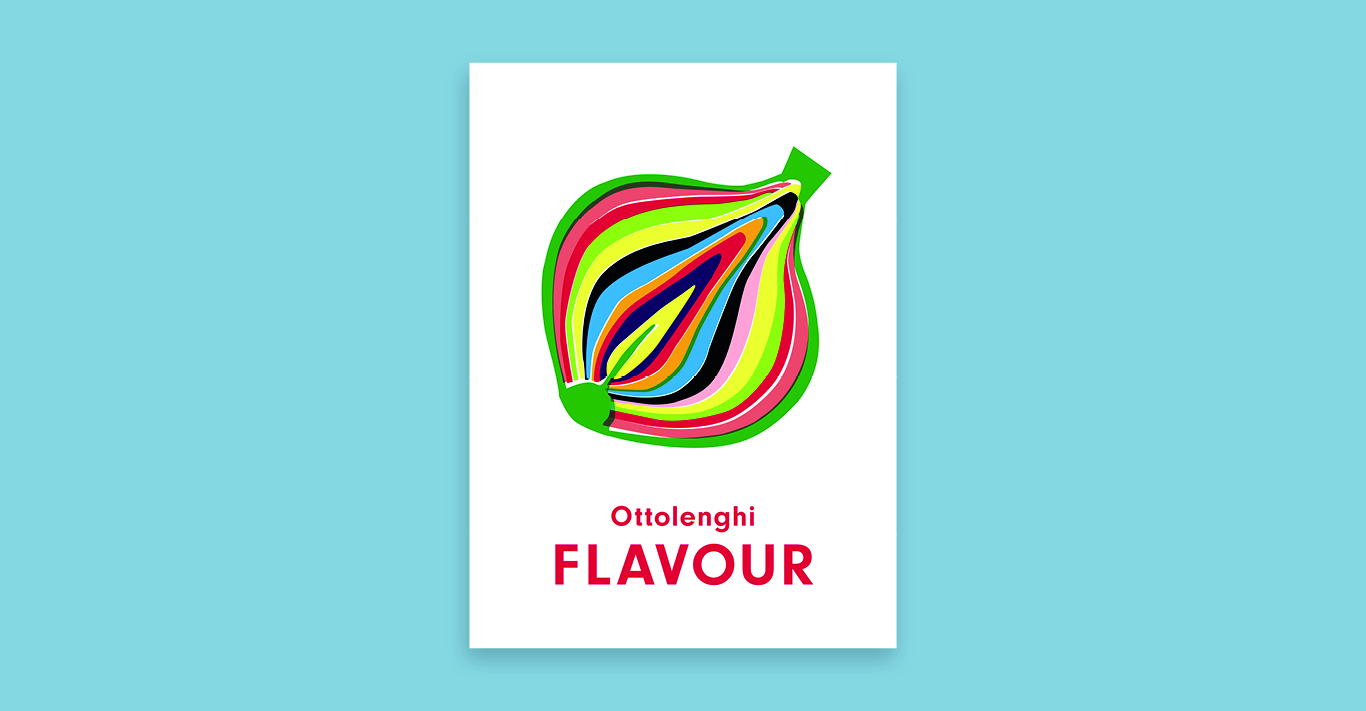For every new cookbook he releases, acclaimed chef Yotam Ottolenghi also offers an accompanying hamper. For his latest tome, Ottolenghi Flavour, £27, which he co-authored with Ixta Belfrage, it’s the most unique and colourful selection yet.
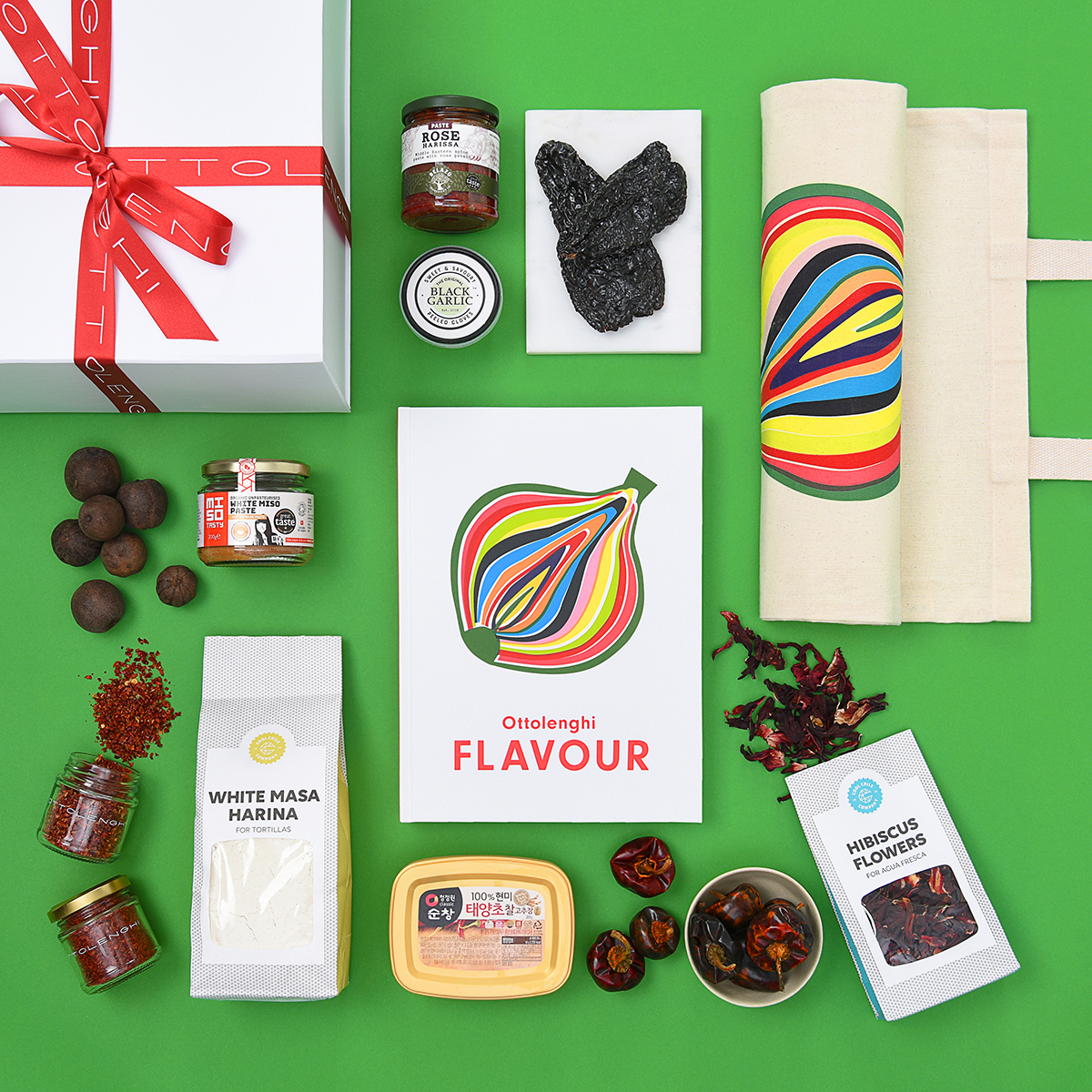
Along with a signed cookbook and tote, it includes cascabel and ancho chillies, masa harina flour, hibiscus flowers, gochujang paste, black garlic and whole dried lime – Ottolenghi and Belfrage’s flavour favourites that are the prefect companion to the book. Celebrating the limitless potential of vegetables, Ottolenghi Flavour explores the three principles of creating innovative vegetable dishes with a series of simple yet elevated recipes such as aubergine dumplings alla parmigiana, and celeriac and goat’s cheese ‘tacos’.
Hamper, £100; ottolenghi.co.uk. Try three recipes from the book, below.
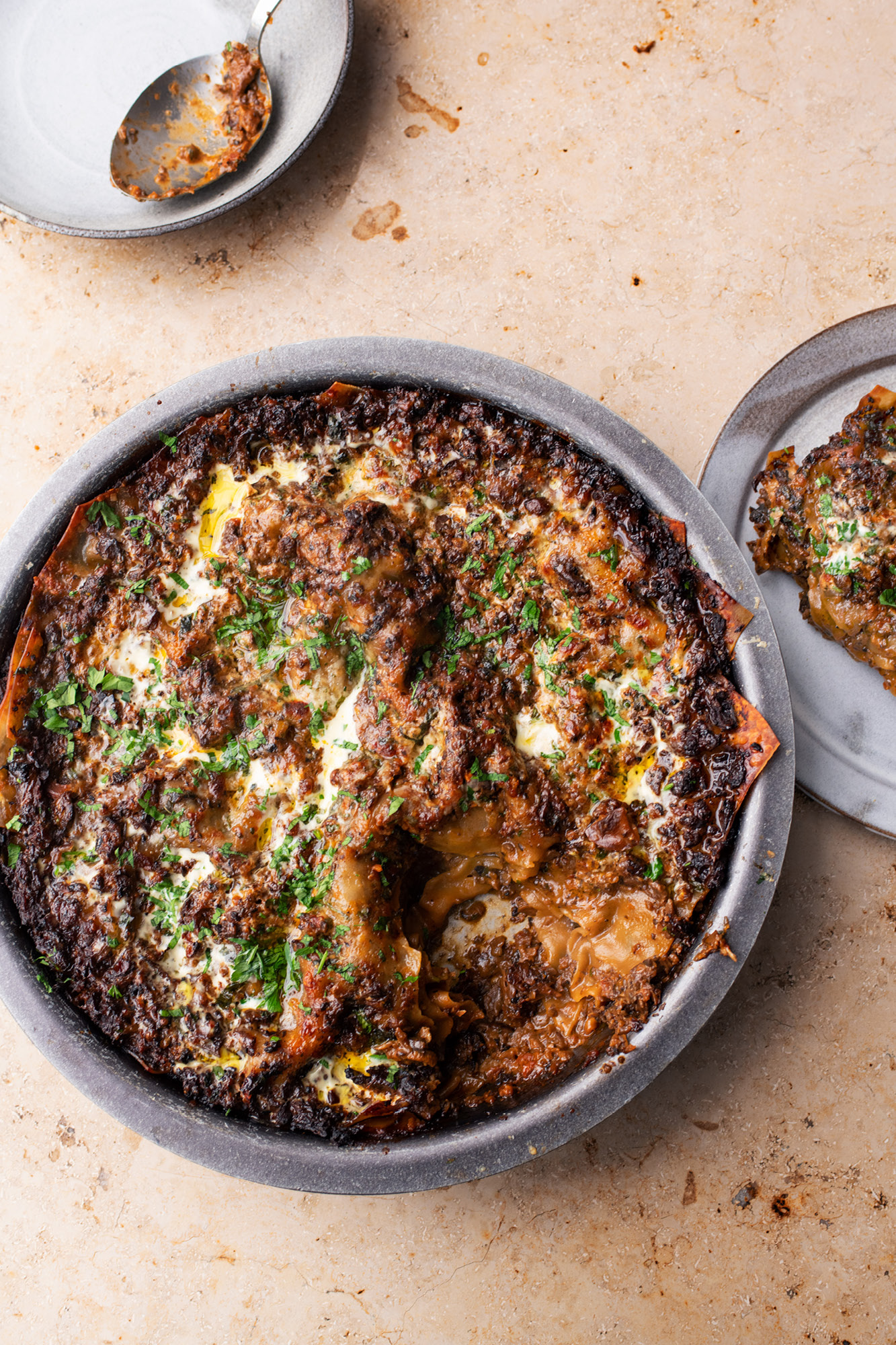
SPICY MUSHROOM LASAGNE
This particular ragù pays homage to penne all’Aconese, the first dish that Ixta fell madly in love with. It’s served at Ristorante Pizzeria Acone, a community-run restaurant in the Tuscan village of Acone, perched at the top of the mountain on which she spent her formative childhood years. The recipe is a closely guarded secret, but the complex, earthy and deeply umami flavour of dried porcini mushrooms is impossible to miss. This is our meatless take on that mythical sauce.
The ragù can easily be made vegan if you lose the cream. It can also be made ahead and refrigerated, ready to be served with pasta or polenta, saving yourself the trouble of constructing the lasagne if you’re short on time.
Reduce the black pepper and lose the chilli for a child-friendly version. If you want to get ahead, the lasagne can be assembled, refrigerated and then baked the next day (once it’s come back up to room temperature).
Ingredients, serves six as a main
750g chestnut mushrooms, halved
500g oyster mushrooms 135ml olive oil, plus extra
for greasing
60g dried porcini mushrooms
30g dried wild mushrooms
2 dried red chillies,
roughly chopped
(deseeded for less heat)
500ml hot vegetable stock
1 onion, peeled and quartered
5 garlic cloves, roughly chopped
1 carrot, peeled and quartered (90g) 2–3 plum tomatoes,
quartered (200g)
75g tomato paste 130ml double cream 60g Pecorino Romano,
finely grated 60g Parmesan, finely
grated 5g basil leaves, finely
chopped
10g parsley leaves, finely chopped, plus an extra tsp to serve
250g dried lasagne sheets (that’s about 14 sheets)
Salt and black pepper
METHOD
1 Preheat the oven to 230°C fan.
2 Put the chestnut and oyster mushrooms into the large bowl of a food processor in three or four batches and pulse each batch until finely chopped (or finely chop everything by hand). Toss the chopped mushrooms in a large bowl with 3 tablespoons of oil and 1 teaspoon of salt and spread out on a large, 40cm x 35cm parchment-lined, rimmed baking tray. Bake for 30 minutes near the top of the oven, stirring three times throughout, until the mushrooms are golden-brown; they will have reduced in volume significantly. Set aside. Reduce the oven temperature to 200°C fan.
3 Meanwhile, combine the dried mushrooms, chillies and hot stock in a large bowl and set aside to soak for half an hour. Strain the liquid into another bowl, squeezing as much liquid from the mushrooms as possible to get about 340ml: if you have any less, top up with water. Very roughly chop the rehydrated mushrooms (you want some chunks) and finely chop the chillies. Set the stock and mushrooms aside separately.
4 Put the onion, garlic and carrot into the food processor and pulse until finely chopped (or finely chop everything by hand). Heat 60ml of oil in a large sauté pan or pot on a medium-high heat. Once hot, add the onion mixture and fry for 8 minutes, stirring occasionally, until soft and golden. Pulse the tomatoes in the food processor until finely chopped (or finely chop by hand), then add to the pan along with the tomato paste, 11⁄2 teaspoons of salt and 13⁄4 teaspoons of freshly cracked black pepper. Cook for 7 minutes, stirring occasionally. Add the rehydrated mushrooms and chillies and theroasted mushrooms and cook for 9 minutes, resisting the urge to stir: you want the mushrooms to be slightly crisp and browned on the bottom. Stir in the reserved stock and 800ml of water and, once simmering, reduce the heat to medium and cook for about 25 minutes, stirring occasionally, until you get the consistency of a ragù. Stir in 100ml of the cream and simmer for another 2 minutes, then remove from the heat.
5 Combine both cheeses and both herbs in a small bowl. To assemble the lasagne, spread one-fifth of the sauce in the bottom of a round 28cm baking dish (or a 30cm x 20cm rectangular dish), then top with a fifth of the cheese mixture, followed by a layer of lasagne sheets, broken to fit where necessary. Repeat these layers three more times in that order, and finish with a final layer of sauce and cheese: that’s five layers of sauce and cheese and four layers of pasta.
6 Drizzle over 1 tablespoon of cream and 1 tablespoon of oil, then cover with foil and bake for 15 minutes. Remove the foil, increase the temperature to 220°C fan and bake for another 12 minutes, turning the dish round halfway. Turn the oven to the grill setting and grill for a final 2 minutes, until the edges are brown and crisp. Set aside to cool for 5 or so minutes, then drizzle over the remaining tablespoon of cream and oil. Sprinkle over the remaining parsley, finish with a good grind of pepper and serve.
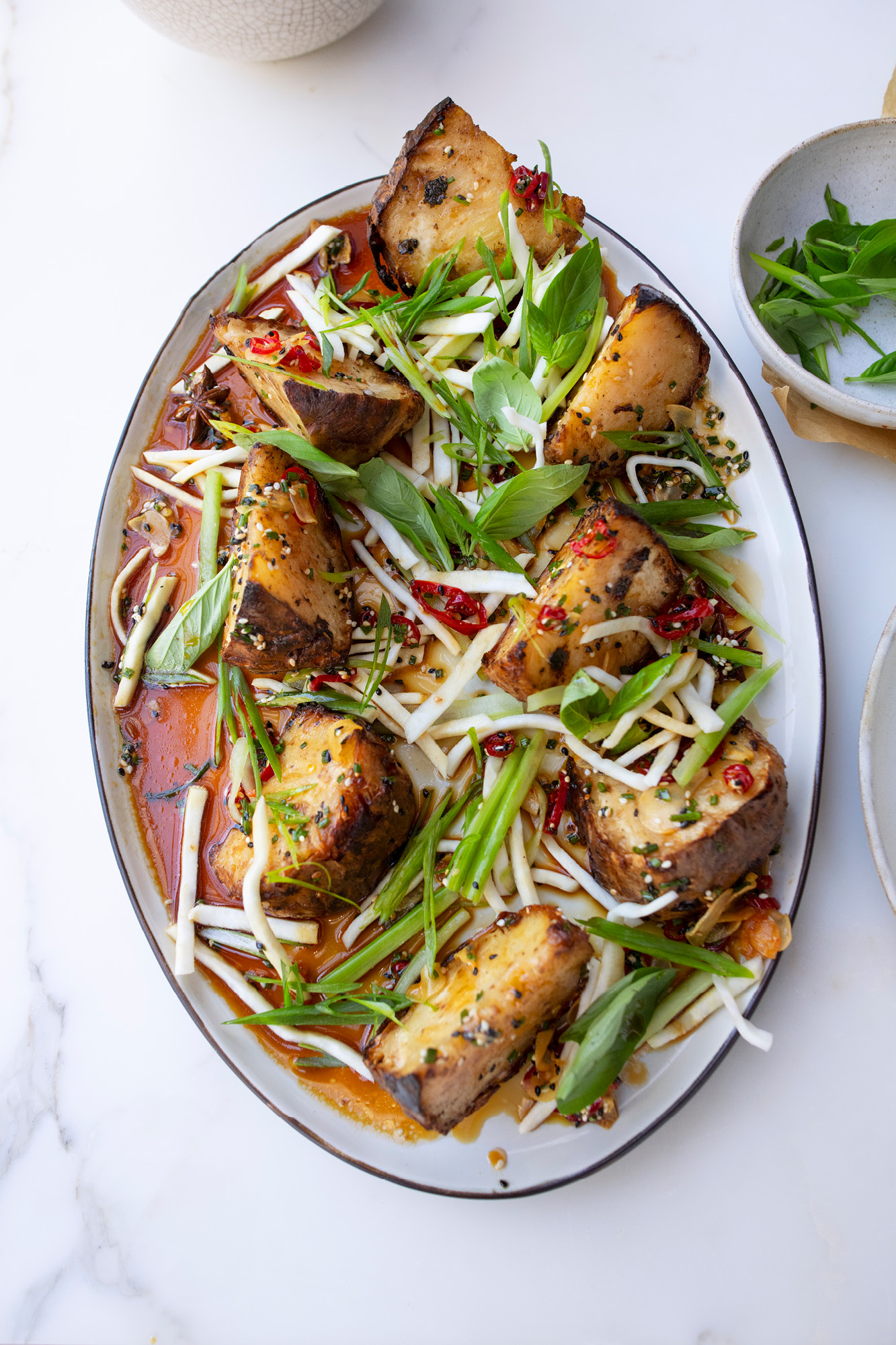
ROASTED AND PICKLED CELERIAC WITH SWEET CHILLI DRESSING
This dish features celeriac in two very different guises – slow-roasted and pickled – giving it textural contrast and flavour complexity, which enables it to take centre stage in a vegetable feast. You can make the dressing a day ahead, but don’t mix in the fried chilli and garlic until you’re ready to serve. You’ll make more pickle than you need, but it keeps in the fridge for three days and is great stuffed into sandwiches and toasties or tossed through a salad. If you don’t want to pickle a whole celeriac, use just half and roast the other half, instead.
Ingredients, serves two as a main or four as a side
1 whole roasted celeriac, cut into 8 wedges
2 spring onions, finely sliced at an angle, to serve
5g picked Thai basil leaves, to serve
flaked sea salt
Pickled celeriac
1 medium celeriac, trimmed, peeled and cut into thin, 6cm-long batons (500g)
3 celery sticks, cut into thin 6cm-long batons (120g)
2 garlic cloves, skin on and crushed with the side of a knife
3 limes: finely shave the skin to get 6 strips, then juice to get 60ml
150ml rice vinegar
Sweet chilli dressing
120ml sunflower oil
5 garlic cloves, very finely sliced
3 red chillies, finely sliced into rounds (30g)
2 whole star anise
11⁄2 tbsp white or black sesame seeds, or a mixture of both, well toasted
21⁄2 tbsp maple syrup
1 tbsp rice vinegar
60ml soy sauce
2 tbsp chives, finely chopped
Method
1 Combine all the ingredients for the pickled celeriac with 20g flaked salt in a large bowl and set aside for at least 2 hours, stirring now and then, while you prepare the rest of the dish. You can make this up to 3 days ahead and keep it refrigerated.
2 Heat the sunflower oil for the sweet chilli dressing in a small saucepan on a medium-high heat. Once very hot, add the garlic, chillies and star anise and fry for 2–21⁄2 minutes, stirring to separate the garlic slices, until the garlic is crisp and pale golden (it will continue to colour after you take it out of the oil, so don’t take it too far). Strain through a sieve set on top of a small heatproof bowl to collect the oil. Set the fried chilli and garlic aside, to serve. Remove 80ml of the aromatic oil and reserve for another recipe. Combine the remaining 40ml of oil with all the remaining ingredients for the dressing.
3 Preheat the oven to 200°C fan.
4 Place the roasted celeriac wedges on a parchment-lined baking tray, cut side up. Make sure they’ve been brushed with their cooking oil and celeriac caramel by this point, and if not, brush with some olive oil and a little maple syrup or honey (see opposite). Roast for 20 minutes, or until golden-brown.
5 Arrange the wedges on a large platter and sprinkle with a little flaked salt. 6. Add the fried chilli and garlic to the dressing and spoon over and around the celeriac. Top with 200g of the pickled celeriac mixture, avoiding the pickling liquid, garlic and lime skin. Garnish with the spring onions and Thai basil, and serve.
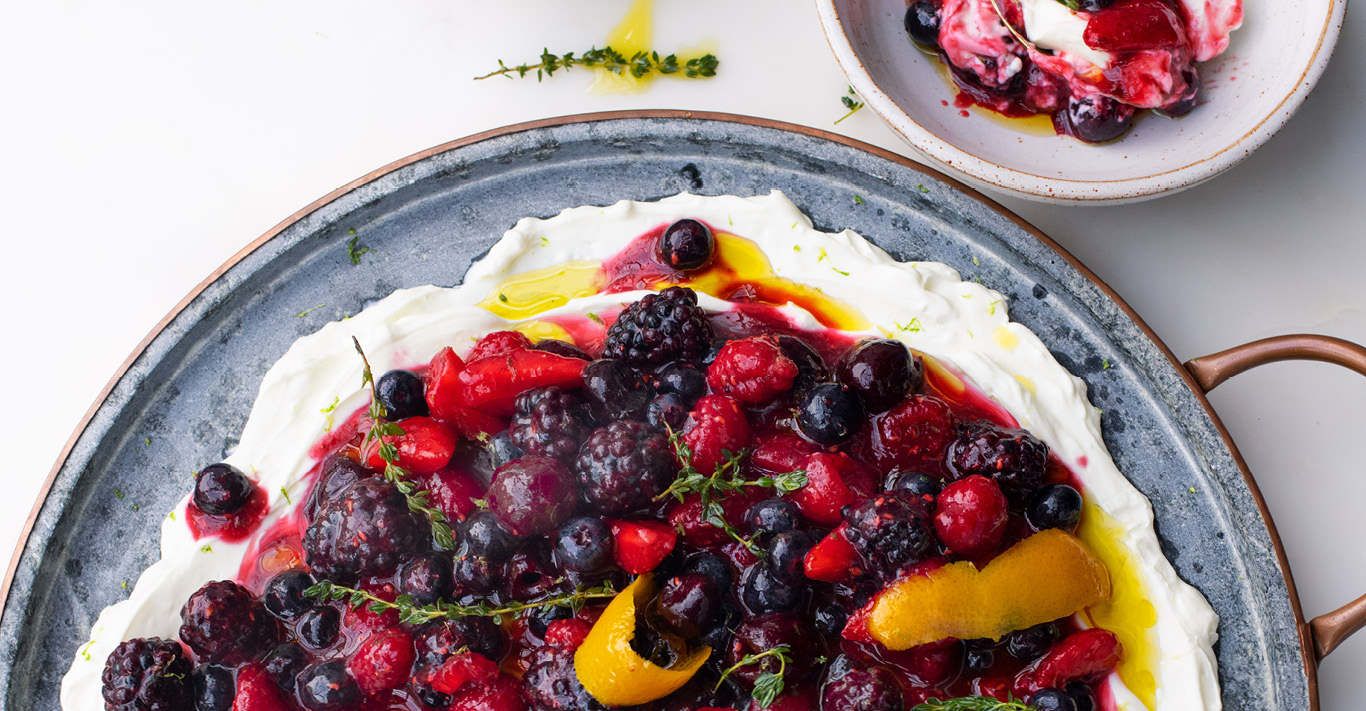
BERRY PLATTER WITH SHEEP’S LABNEH AND ORANGE OIL
This display of the season’s best can double up as a light dessert or as a brunch centrepiece. You can make your own labneh but it requires draining the yoghurt for a good 24 hours, or you can make everything easily on the day using shop- bought labneh or some Greek-style yoghurt mixed with a little double cream. The berries you use are totally up to you, depending on what’s good and not too expensive. You can use fewer types, or some frozen berries, if you like, especially for those which get blitzed in the recipe. You’ll make more oil than you need; store it in a glass jar to drizzle over salads or lightly cooked vegetables.
Ingredients, serves six
900g sheep’s yoghurt, or cow’s yoghurt as an alternative
1⁄2 tsp salt 100ml good-quality olive oil
10g lemon thyme sprigs, plus a few extra picked thyme leaves to serve
1 orange: finely shave the skin to get 6 strips
200g blackberries
250g raspberries
300g strawberries, hulled and halved lengthways (or quartered if they’re larger)
50g caster sugar
1 lime: finely grate the zest to get 1 tsp, then juice to get 1 tbsp
200g blueberries
150g cherries, pitted
Method
1 Put the yoghurt and salt into a medium bowl and mix well to combine. Line a colander with a piece of muslin large enough to hang over the sides and place the colander over a bowl. Transfer the yoghurt to the muslin and fold over the sides to completely encase the yoghurt. Place a heavy weight over the muslin (a few tins or jars will do), and transfer to the fridge to drain for at least 24 hours (and up to 48).
2 Meanwhile, put the oil into a small saucepan, for which you have a lid, on a medium heat. Heat gently for about 7 minutes, or until tiny air bubbles form. Remove from the heat, add the thyme and orange strips, then cover with a lid and leave to infuse, ideally overnight, though half an hour will also do the job.
3 The next day, put 50g of blackberries, 100g of raspberries and 100g of strawberries into the small bowl of a food processor along with the sugar and lime juice and blitz until completely smooth. Put all the remaining berries and the cherries into a large bowl along with the blitzed fruit and gently combine. You can serve it straight away or leave it in the fridge for a few hours, bringing it back to room temperature before serving.
4 Spread the labneh out on a large platter. Spoon over the berries, then sprinkle with the lime zest. Drizzle with 2 tablespoons of the infused oil, along with a couple of the orange strips and the extra picked thyme leaves.
Extracted from Ottolenghi FLAVOUR by Yotam Ottolenghi and Ixta Belfrage (Ebury Press, £27)
Photography: Jonathan Lovekin

